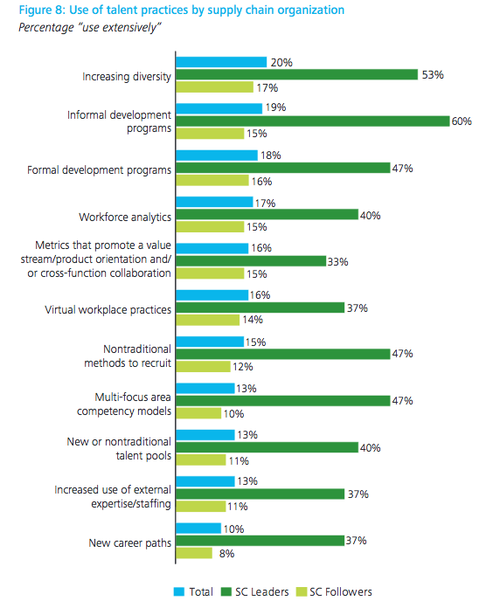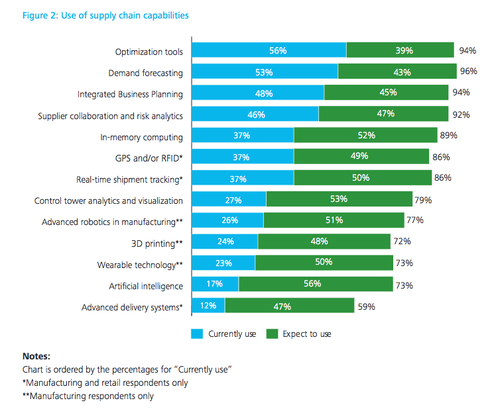Painting a Portrait of a Supply Chain Leader
As the supply chain becomes more strategic to the organization, OEMs who are ahead of the pack are putting their focus to putting the right supply chain pros on the team and investing in the right technologies to get things done systematically and efficiently. Those are the primary finding of Deloitte's 3rd annual supply chain survey.
"Organizations that we have identified as supply chain leaders (that are higher performing than their peers in terms of operating and business performance) are driving right at technology rather than shying away from it, and are addressing the talent issue head on," said Kelly Marchese, principal, Deloitte Consulting LLP, in an interview with EBN. "These efforts are helping them pull ahead of the followers pretty dramatically."
The report, which is titled Supply Chain Talent of the Future, surveyed 400 executives from global companies. Most had revenues over $1 billion. In defining "supply chain leaders," the researchers based the measurement on two metrics: inventory turnover and the percentage of on time and in full deliveries the organization made.
The ever-widening gap in supply and demand for supply chain talent is well documented--as is the need for solid supply chain talent. "The exponential gap in talent shortage is growing and accelerating," said Marchese. "However, those organizations that are having success realize the value of having the right people and are being forward thinking and analytical about attracting talent. They are getting downright down and dirty in terms of getting people."
Organizations winning the talent competition are thinking outside of the box for ways to identify, attract, and retain good people. "Supply chain leaders are doing non-traditional things like aggressively going after people who have experienced hires and hosting events to attract people not actively looking for jobs," said Marchese.
The next generation of supply chain talent, the Millenials, also offer benefits beyond what the movers and shakers already in the industry can provide. " Now, organizations are looking at millennials, who fearless in terms of analytics and technologies, and not encumbered by way we've always done supply chain," said Marchese. "And, they haven't necessarily developed a loyalty to one organization yet."
Talent isn't the only element for success. In addition, supply chain leaders create a balance between being aware of cost containment and product/service differentiation—taking a both/and approach rather than choosing either/or. "The leaders are doing more," said Marchese. "They are trying many things."
Often, that translates into trying to leverage new technologies and approaches. "With innovation, you can't be afraid to fail," said Marchese. "Leading organizations are willing to try many things: advanced technologies, automated reality, sensor-based logistics, etc." Leaders are two to three times more likely to be tackling these emerging technologies than the followers, she added.
In the end, supply chain leaders have a guarded sense of confidence when it comes to their supply chain. In fact, while most leading companies believe they have the competencies necessary today, fewer are confident about five years from now. "There is recognition on the part of these organizations that maintaining and gaining capabilities is not being to be easy," said Marchese.
"Organizations that we have identified as supply chain leaders (that are higher performing than their peers in terms of operating and business performance) are driving right at technology rather than shying away from it, and are addressing the talent issue head on," said Kelly Marchese, principal, Deloitte Consulting LLP, in an interview with EBN. "These efforts are helping them pull ahead of the followers pretty dramatically."
The report, which is titled Supply Chain Talent of the Future, surveyed 400 executives from global companies. Most had revenues over $1 billion. In defining "supply chain leaders," the researchers based the measurement on two metrics: inventory turnover and the percentage of on time and in full deliveries the organization made.
The ever-widening gap in supply and demand for supply chain talent is well documented--as is the need for solid supply chain talent. "The exponential gap in talent shortage is growing and accelerating," said Marchese. "However, those organizations that are having success realize the value of having the right people and are being forward thinking and analytical about attracting talent. They are getting downright down and dirty in terms of getting people."
Organizations winning the talent competition are thinking outside of the box for ways to identify, attract, and retain good people. "Supply chain leaders are doing non-traditional things like aggressively going after people who have experienced hires and hosting events to attract people not actively looking for jobs," said Marchese.
The next generation of supply chain talent, the Millenials, also offer benefits beyond what the movers and shakers already in the industry can provide. " Now, organizations are looking at millennials, who fearless in terms of analytics and technologies, and not encumbered by way we've always done supply chain," said Marchese. "And, they haven't necessarily developed a loyalty to one organization yet."
Talent isn't the only element for success. In addition, supply chain leaders create a balance between being aware of cost containment and product/service differentiation—taking a both/and approach rather than choosing either/or. "The leaders are doing more," said Marchese. "They are trying many things."
Often, that translates into trying to leverage new technologies and approaches. "With innovation, you can't be afraid to fail," said Marchese. "Leading organizations are willing to try many things: advanced technologies, automated reality, sensor-based logistics, etc." Leaders are two to three times more likely to be tackling these emerging technologies than the followers, she added.
In the end, supply chain leaders have a guarded sense of confidence when it comes to their supply chain. In fact, while most leading companies believe they have the competencies necessary today, fewer are confident about five years from now. "There is recognition on the part of these organizations that maintaining and gaining capabilities is not being to be easy," said Marchese.





No comments:
Post a Comment